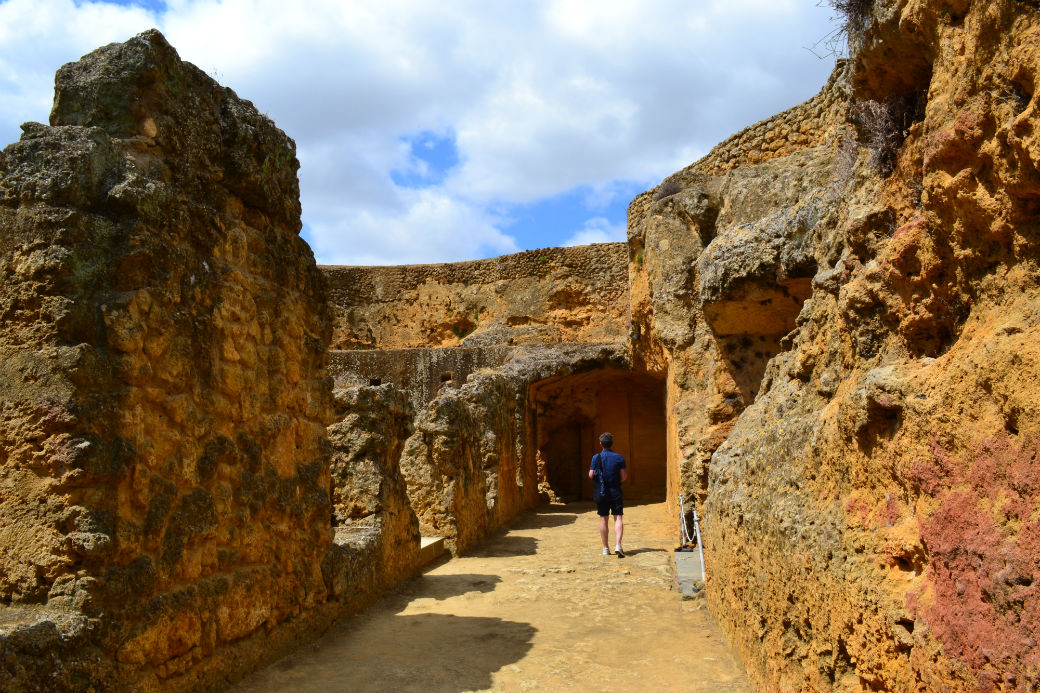
We never saw the ancient Moorish city of Carmona under a clear blue sky, alas. Freakishly cool weather in the late teens celsius persisted during our weekend stay in June, the wind chill reducing the temperature further. The hotel pool lay uncleaned, loungers unused. And the epic view (above) from this fortress town over the vast Campina – a thinly-populated patchwork quilt of fields peppered with sheep – looked almost English under cloudy skies. (At least the clink of the goat bells gave it a Mediterranean edge.)
Yet Carmona is a beauty of a town, its history palpable: founded by the Carthaginians in the 3rd Century BC, it was both major Roman settlement as well as taifa – or independent state – in Moorish times. Around 45 mins on the bus from sweltering Seville, it’s also surprisingly accessible, while still feeling like something of a discovery.


Stop to consider the old town’s history, however: circled by 4km of city walls, the Puerta de Sevilla, which you’ll enter on arrival, makes an impressive double gateway of Roman origin. A walk up to the Alcazar, an Almohad fortress ruined by earthquake in 1504, is an atmospheric corner of what can feel like an island, so high is the rock above the plain.
But even more memorable the City of the Dead, a Roman necropolis excavated between 1881 and 1915, about a 15 minute stroll from the old town along a dusty road.

Here, amid the heady scents of pine, lavender, and thyme, surrounded by olive trees and flowering cacti, the Roman burial chambers are hewn from rock and frescoed with images of birds and fruit. The site is deeply peaceful: mules neigh in surrounding meadows as you wander the 900 family subterranean tombs dating from 2nd century BC to 4th century AD. Its highlight? The Tomba de Servilia, a colonnaded temple with vaulted side chambers and separate columbaria for the servants, cremation pits starkly visible too.
Eating & Drinking

The hot restaurant

Much better was La Yedra, where, within a small Andalucian courtyard, we feasted on a more contemporary take on the traditional delicacies: veal carpaccio, turbot with courgette and Iberican ham, and a flavoursome pork solomillo (tenderloin) with padron peppers and squash. Decent prices on wine too. Calle del General Freire, 6, phone +34 954 14 45 25
Accommodation

 For a five star hotel, service was a little more laid back than might be expected, not necessarily a bad thing, and French-born Laura, who seemed to hold the fort single-handed throughout our stay, managed admirably. But the overall experience was like staying in a very wealthy friend’s retreat (no I don’t know any, either). It’s not without its flaws (and perhaps the bedrooms could use a spruce-up) but the Casa de Carmona has real soul. Prices start at €80 per night. Head here for more info.
For a five star hotel, service was a little more laid back than might be expected, not necessarily a bad thing, and French-born Laura, who seemed to hold the fort single-handed throughout our stay, managed admirably. But the overall experience was like staying in a very wealthy friend’s retreat (no I don’t know any, either). It’s not without its flaws (and perhaps the bedrooms could use a spruce-up) but the Casa de Carmona has real soul. Prices start at €80 per night. Head here for more info.


